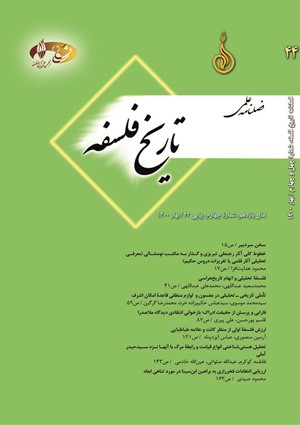ارزیابی انتقادات فخررازی به براهین ابنسینا در مورد تناهی ابعاد
محورهای موضوعی : Etymology of philosophical terms
1 - استاديار گروه فلسفه و حكمت اسلامي دانشگاه شاهد، تهران، ايران
کلید واژه: تناهینامتناهیابعادابن سینافخررازی,
چکیده مقاله :
مسئلة تناهی ابعاد از قدیمیترین مباحث فلسفة طبيعي است که نتایج آن وارد حوزة فلسفة الهی نیز شده است. سؤال اینست که ابعاد عالم و هر یک از اجسام طبیعی محدود و متناهی است یا نامحدود و نامتناهی؟ ارسطو نخستین فیلسوفی است که در تاریخ فلسفه به بررسی این مسئله پرداخته و نامتناهی بودن ابعاد یک جسم و عالم طبیعی را ممتنع دانسته است. ابنسینا نیز بپيروي از ارسطو، ابعاد جسم را متناهی میداند و براهین سهگانه تطبیق، مسامته و سلّمی را براي اثبات این نظریه بيان ميكند. فخررازی که مهمترین منتقد ابنسینا در تاریخ فلسفه است، در این مسئله نیز انتقاداتي بر نظریة ابنسینا وارد میداند. در اين پژوهش اثبات ميشود که اکثر اشکالات فخررازی در اينباره ناشی از خلط ذهن با خارج و مغالطة میان احکام مقولات نهگانه با مقولۀ کمّ متصل است.
The finitude of dimensions is one of the oldest problems of natural philosophy, the consequences of which have entered the realm of divine philosophy. The question is whether the dimensions of the world and each natural body is finite and limited or infinite and limitless. Aristotle was the first philosopher who studied this problem in the history of philosophy and ruled out the infinity of the dimensions of bodies and the natural world. In the same view, Ibn Sīnā maintained that the dimensions of body are finite and presented the three-fold arguments of correspondence, parallelism, and hierarchy in order to demonstrate this theory. Fakhr al-Dīn Rāzī, who is the most important critic of Ibn Sīnā in the history of philosophy, advanced some criticisms against this theory of Ibn Sīnā. This study proves that most of Fakhr al-Rāzī’s misconceptions in this regard originate in mixing the mind with the outside and the principles of the nine-fold categories with the category of quantity.
ابنسینا (1375) الاشارات و التنبیهات، قم: نشر البلاغه.
ابنسینا (1376) الالهيات من كتاب الشفاء، تصحیح حسن حسنزاده آملى، قم: بوستان كتاب.
ابنسینا (1382) الأضحوية فی المعاد، تصحیح حسن عاصى، تهران: شمس تبريزى.
ابنسینا (1400ق) رسائل، تصحيح محسن بیدارفر، قم: بيدار.
ابنسینا (1404الف) التعلیقات، تصحيح عبدالرحمن بدوی، قم: مکتب الاعلام الاسلامی.
ابنسینا (1404ب) الطبیعیات من الشفاء، تصحيح ابراهیم مدکور، قم: کتابخانه آیتالله مرعشی نجفی.
ابنسینا (1980م) عيون الحكمة، تصحیح عبدالرحمن بدوى، بيروت: دارالقلم.
ارسطو (1390) سماع طبیعی، ترجمه محمدحسن لطفی، تهران: طرح نو.
جوادی آملی، عبدالله (1386الف) رحیق مختوم، قم: اسراء.
جوادی آملی، عبدالله (1386ب) منزلت عقل در هندسه معرفت دینی، قم: اسراء.
رازی، فخرالدین (1373) شرح عيون الحكمة، تحقيق محمد حجازى، تهران: مؤسسة الصادق (ع).
رازی، فخرالدین (1384) شرح الاشارات و التنبيهات، تهران: انجمن آثار و مفاخر فرهنگى.
رازی، فخرالدین (1407ق) المطالب العالیه من العلم الالهی، تصحیح سقا احمد حجازی، بیروت: دار الکتاب العربي.
رازی، فخرالدین (1411ق) المباحث المشرقيه، تصحیح محسن بيدارفر، قم: بيدار.
رازی، فخرالدین (1420ق) التفسیر الکبیر، بيروت: دار احياء التراث العربي.
رازی، فخرالدین (1986م) الأربعين فی أصول الدين، قاهره: مكتبة الكليات الأزهرية.
میرداماد، ميرمحمدباقر (1367) القبسات، تصحیح مهدى محقق، تهران: دانشگاه تهران.

